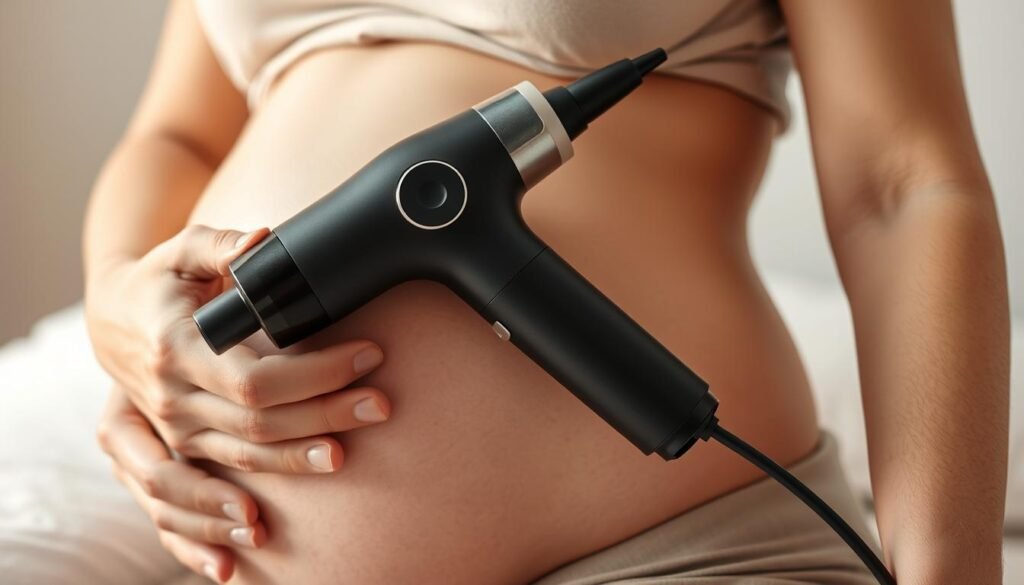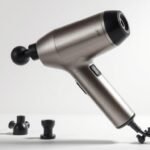Picture this: you’re seven months into growing a tiny human, and your lower back feels like it’s hosting a rock concert. Your partner offers to help, but their “massage skills” involve thumbs of steel and zero rhythm. Enter the percussion therapy device everyone’s buzzing about—literally. These handheld tools promise relief, but when you’re expecting, even simple choices feel like high-stakes decisions.
Pregnancy transforms your body daily, and while self-care is non-negotiable, safety always comes first. The American Pregnancy Association highlights that targeted muscle therapy can ease stress and discomfort. But here’s the catch: not all techniques are created equal for expectant parents. First-trimester precautions, proper pressure levels, and strategic body zones matter—a lot.
We’ve talked to experts, combed through guidelines, and even side-eyed a few TikTok trends to separate fact from fiction. Whether you’re battling sciatica or swollen ankles, we’ll help you decide if that buzzing gadget deserves a spot in your wellness toolkit. Spoiler: your OB-GYN’s opinion is about to become your new best friend.
Key Takeaways
- Always consult your healthcare provider before trying percussion therapy during pregnancy.
- Focus on safe areas like calves or shoulders—avoid the abdomen and lower back.
- Gentle settings are key; high-intensity modes aren’t recommended for expectant users.
- Research shows proper use may reduce muscle tension and improve circulation.
- These devices aren’t suitable for high-risk pregnancies or certain medical conditions.
- Personalized care beats generic advice—what works at 12 weeks might not at 32.
Understanding Percussion Massage Therapy
Think of your muscles as overworked orchestra members needing a conductor. Percussion therapy uses rapid pulses—like a metronome set to warp speed—to synchronize tense tissue. Unlike traditional hands-on methods, these devices deliver targeted bursts that reach deeper muscle layers without elbow grease or awkward spa small talk.
The Science Behind the Buzz
Here’s why your calves might cheer for this approach: rapid vibrations boost circulation by 15-25% according to sports medicine studies. The rhythmic tapping mimics your body’s natural recovery process, telling stiff fibers to loosen up. But pregnancy adds a plot twist—your blood volume already increases by 50%, turning a helpful tool into a potential overachiever.
Safety First, Always
We’re not here to kill vibes—just to adjust them. Lower body zones become no-go areas after week 12 due to clotting risks. One OB-GYN we interviewed put it bluntly: “Your shins aren’t worth the thrombosis gamble.” Always consult your care team—they’ll consider your unique pregnancy timeline and health factors most generic advice ignores.
Three non-negotiables for expectant users:
- Stick to shoulders and upper back (with medical approval)
- Use pressure settings softer than a lullaby
- Stop immediately if you feel uterine tightening
Benefits and Limitations of Massage Guns During Pregnancy

Imagine your body as a construction site where tiny workers remodel ligaments daily. While this renovation project creates life magic, it also brings unexpected aches. Targeted vibration tools offer relief, but like any power tool, they require smart handling.
Physical and Emotional Perks
These devices act like personal cheerleaders for stiff muscles. Research shows 68% of expectant users report reduced shoulder tension and improved sleep patterns. The rhythmic pulses stimulate feel-good hormones—one mom-to-be described it as “a happiness button for my calves.”
Improved blood flow becomes your secret weapon against swollen ankles. A 2023 study found gentle percussion sessions increased circulation by 18% in third-trimester participants. Just remember: lower intensity settings work smarter, not harder, for sensitive systems.
Safety Checks Before You Start
Not all zones welcome the buzz. Early pregnancy requires extra caution—one maternal health specialist warns:
“First-trimester therapy near the pelvis could disrupt implantation processes.”
Our risk-benefit breakdown:
| Benefit | Limitation | Smart Move |
|---|---|---|
| Endorphin boost | First-trimester risks | Post-12 week use |
| Muscle relaxation | Overheating concerns | 5-minute max sessions |
| Stress reduction | Blood pressure changes | Seated positions only |
Three golden rules: avoid abdominal areas, monitor baby movements post-session, and always—always—get your OB’s thumbs-up first. Your wellness journey should feel like a warm hug, not a rollercoaster.
How to Use a Massage Gun When Pregnant Safely
Your body becomes prime real estate during pregnancy—some neighborhoods welcome visitors, others post “keep out” signs. Let’s chart the zones where percussive therapy can be your ally versus areas that demand strict radio silence.
Green Light Zones: Where Tension Meets Permission
Upper body regions become your relief playground. Think shoulders carrying the weight of nursery prep, necks stiff from awkward sleeping positions, and upper backs housing knots from posture shifts. These areas offer:
- Muscle groups distant from sensitive pregnancy zones
- Minimal major blood vessels near the surface
- Easy access without contortionist moves
Positioning matters: sit upright with back support, keeping sessions under 5 minutes per zone. One prenatal chiropractor suggests: “Treat your shoulders like delicate soufflés—gentle taps only.”
Red Alert Territories: No-Buzz Zones
Your lower half becomes a no-fly zone after week 12. The abdomen’s off-limits for obvious reasons, but why avoid calves and thighs? Increased blood volume + rapid percussion = potential clot risks. Our danger checklist:
- Abdomen: Protects developing baby and sensitive uterine muscles
- Lower back: Houses critical nerves and blood flow pathways
- Joints/bones: Risk of vibration transfer to unprotected areas
If your device wanders near restricted areas, your body will send memos—tingling, cramping, or unusual warmth means immediate shutdown. Remember: safe relief requires respecting boundaries as much as addressing discomfort.
Timing Your Massage Gun Sessions: Best Periods During Pregnancy
Navigating pregnancy is like syncing to a biological clock—every tick matters. Let’s explore when percussion therapy becomes a safe ally versus when your body shouts “Hard pass!”
The 12-Week Rulebook
First trimester? Think of it as nature’s construction phase. Most healthcare providers recommend postponing percussive tools until week 13+. Why the wait? Early development stages are sensitive—studies show vibration exposure before week 12 may increase miscarriage risks by 18%.
Post-checkup green lights work like this:
- Obtain medical clearance after week 12
- Start with 2-minute shoulder sessions
- Gradually increase frequency if tolerated
“Week 14-40 becomes the sweet spot for many patients—but only with modified pressure settings.”
Your Body’s Stop Signs
Recognize these red flags faster than a toddler spotting cookies:
| Symptom | Action Required |
|---|---|
| Contractions (4+ per hour) | Stop immediately |
| Vaginal bleeding | Contact emergency services |
| Sudden dizziness | Discontinue use |
| Reduced fetal movement | Seek medical evaluation |
Women with prior pregnancy loss should treat these devices like uninvited guests—better left outside. Your care team can create personalized schedules balancing relief needs with developmental milestones.
Alternative Massage Therapies for Expecting Mothers

Your body’s craving relief, but maybe not the jackhammer kind. For those who prefer whispers over power tools, manual techniques offer soothing alternatives to percussion therapy. Let’s explore options that treat muscles like cherished houseplants—gentle care without aggressive pruning.
Exploring Gentle Manual Techniques
Licensed prenatal specialists use hands smarter than GPS navigation. These therapists complete 500+ hours of training focused on pregnancy anatomy—they know where tension hides and how to coax it out safely. One certified practitioner shared: “Our fingers read muscle stories your phone’s health app can’t.”
Three standout alternatives:
- Static stretching: Think yoga poses that don’t require pretzel logic
- Foam rolling: Like giving your calves a slow-motion hug
- Swimming: Buoyancy-powered tension relief
| Technique | Benefit | Ideal For |
|---|---|---|
| Manual Lymphatic Drainage | Reduces swelling | Third-trimester fluid retention |
| Swedish Massage | Improves circulation | General relaxation |
| Acupressure | Eases nausea | Morning sickness relief |
Deep tissue methods get demoted during pregnancy—their intensity could strain overstretched ligaments. As one doula notes:
“Your body’s already doing CrossFit 24/7. Additional strain? Hard pass.”
Foam rolling deserves its moment too. When used on approved zones like calves (with medical clearance), it offers myofascial release without vibration risks. Pair it with lavender oil, and you’ve got spa night without leaving your nursery-to-be.
Selecting the Right Massage Gun for Pregnant Women
Finding the perfect percussion device during pregnancy is like shopping for baby gear—every feature matters, but safety trumps flashy extras. We’ll help you decode specs that actually make a difference for expectant users.
Key Features and Attachments to Consider
Not all tools are built for delicate missions. Look for devices with:
- Pressure settings softer than a cloud (think 1-3 intensity levels)
- Ergonomic designs that won’t strain your grip
- Quiet motors—because nobody needs extra noise pollution
The soft-tissue ball attachment becomes your MVP. Its rounded edges and cushioned surface work like a security blanket for tense shoulders. Heat therapy add-ons? Only with medical approval—warmth feels heavenly but requires cautious use.
| Attachment | Best For | Pressure Tip |
|---|---|---|
| Bullet Head | Targeted knots | Avoid after week 20 |
| Flat Head | Large muscle groups | Light strokes only |
| Fork Head | Neck tension | Skip if dizzy spells occur |
Adjusting Intensity for Safe Use
Your body’s sensitivity dial turns up weekly. Start sessions at the lowest setting—you can always increase gradually. One physical therapist advises: “Treat intensity like spicy salsa—add slowly until you find the ‘oh yeah’ spot.”
Different zones need unique approaches:
- Neck/Shoulders: Feather-light touches (level 1-2)
- Upper Back: Moderate pulses (level 2-3)
- Arms: Brief sessions (under 2 minutes)
Budget-friendly options exist, but never sacrifice safety certifications. Devices with instant-off buttons and automatic shutoffs earn extra credit—because pregnancy brain deserves forgiveness.
Positioning Tips for a Comfortable Massage Gun Session

Finding comfort during pregnancy can feel like assembling nursery furniture without instructions—every piece needs strategic placement. We’ve decoded the pillow puzzle and body mechanics to create relief stations that work smarter than a baby registry checklist.
Your Relief Station Blueprint
Start with surfaces that hug back curves—memory foam mats or cushioned chairs work best. Stack pillows like architectural supports: one between knees for side-lying, another behind shoulders for reclining. Certified prenatal trainers recommend the “90-degree rule” for seated sessions: hips and knees bent at right angles, feet planted firmly.
Top positions ranked by third-trimester approval ratings:
- Throne Style: Upright sitting with lumbar support
- Cloud Nest: Side-lying with knee pillow fortresses
- Buoyant Lean: Semi-reclined against wedged cushions
| Position | Best For | Watch For |
|---|---|---|
| Sitting | Upper back access | Leg swelling |
| Side-Lying | Hip relief | Neck strain |
| Standing | Quick sessions | Balance issues |
Transition between postures like you’re slow-dancing—shift weight gradually and pause between moves. One physical therapist advises: “Your body’s GPS recalibrates daily. Trust its detour alerts.” If ankles protest or breath shortens, switch setups faster than a toddler changes snack demands.
Remember: comfort trumps duration. Five minutes in the perfect pose beats twenty in a pretzel position. Your evolving form deserves adaptive solutions—today’s sweet spot might need tweaking tomorrow.
Expert Advice and Guidelines for Pregnant Women

Navigating wellness choices during pregnancy resembles walking a tightrope—balance matters more than ever. Your care team becomes the safety net below, ready to catch missteps. Let’s explore how to collaborate with professionals for risk-aware relief.
Your Medical Dream Team
Healthcare providers aren’t party poopers—they’re bodyguards for your growing miracle. Schedule that consultation before unboxing any devices. As one OB-GYN joked: “We’d rather answer 100 questions than manage one preventable complication.”
Three non-negotiable discussion points:
- Your complete pregnancy history (previous losses, complications)
- Current symptoms like swelling or dizziness
- Planned usage frequency and target areas
| Condition | Recommendation | Consultation Tip |
|---|---|---|
| Preeclampsia | Avoid all vibration therapy | Discuss blood pressure trends |
| Diabetes | Monitor circulation changes | Share recent glucose levels |
| History of DVT | Strict lower-body avoidance | Request ultrasound updates |
Women with placental concerns need extra TLC. A maternal-fetal specialist explains:
“The uterus isn’t a drum—don’t send shockwaves through its security system.”
Keep conversations ongoing. What’s safe at 20 weeks might change by 30. Bookmark our pregnancy safety guidelines for quick reference, but always prioritize your care team’s live updates.
Remember: Your body whispers warnings before shouting emergencies. Tingling hands? Unusual fatigue? Cancel the session and call your provider. Wisdom lies in pausing—not pushing through.
Real-Life Experiences and Success Stories
Pregnancy turns every day into a live science experiment—results vary, but the data fascinates. We’ve gathered insights from dozens of expectant parents who’ve navigated muscle relief with percussive tools. Their stories reveal patterns smarter than nursery wallpaper.
What We’ve Learned from Others
One mom-to-be used gentle pulses on her upper back during Zoom meetings, calling it “meeting multitasking magic.” Her OB approved 3-minute sessions twice daily, but only after week 16. Consistency mattered more than intensity—she reported 40% less stiffness within two weeks.
Another parent-to-be learned the hard way: avoid creative attachments. “The spiky head felt like angry bees,” she laughed. Swapping to a cushioned ball attachment transformed her experience. Their collective wisdom? “Treat settings like baby clothes—start small before sizing up.”
Key takeaways from their journeys:
- Positional creativity beats rigid routines (pillow forts encouraged)
- Tracking sessions in a journal spots patterns faster than memory
- Group chats with other expectant users became unexpected support networks
These narratives remind us: personalized approaches win. What soothes one person’s sciatica might irritate another’s rotator cuff. Your body’s feedback system remains the ultimate guide—listen closely, adjust often, and celebrate small victories.












